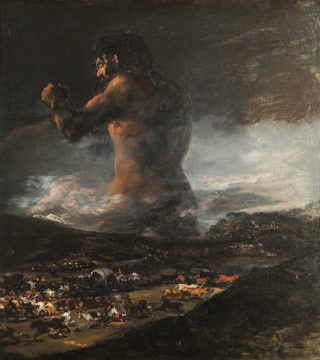 Geoff Mann in the LRB:
Geoff Mann in the LRB:
The American economist William Nordhaus opened his Nobel Prize speech in 2018 with a slide of the painting El Coloso, traditionally attributed to Goya and completed sometime between 1808 and 1812. Like Goya’s better-known images of the Madrid uprising of 2 May 1808 and the bloody retribution that came after, the painting depicts the calamitous violence of the Peninsular War, which followed Napoleon’s invasion of Spain. But while Goya’s intentions are clear in El Dos and El Tres de Mayo, it is much less obvious what is going on in El Coloso. A giant man, shrouded in mist, looms over the hills. In the dark valley below, people and animals are caught in desperate flight. Only a single donkey remains still, unflustered. The giant is half-turned away from us and from the refugees, his fist raised, ready to fight. But his eyes appear to be closed. Who or what presents the threat isn’t visible to us.
Is the colossus protecting the people, or is it him they fear? Does he symbolise the French armies wreaking havoc across the Spanish hills or Spain standing up to the invaders? If the giant is Spain, which Spain is he: the Bourbons demanding restoration or the liberal republicanism that flared briefly at the time Goya was painting? Nordhaus, whose speech was about the contribution he has made to the economics of climate change, didn’t engage with any of this.
More here.
